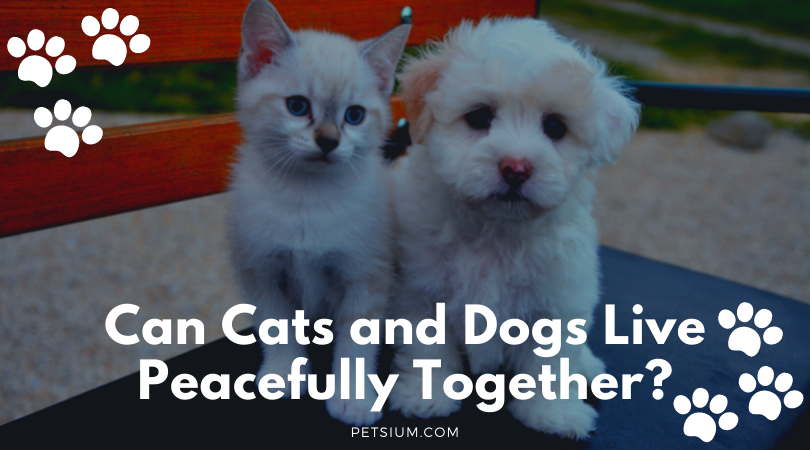Cats and dogs have different views on life. Can the two species live together peacefully?
Dreaming of adding a dog to your happy, contented cat household? Worried the fur may fly? You can maintain harmony in your newly expanded pet household as long as you’re willing to be patient, responsible and caring.

First, recognize cats and dogs are two different species and they view the world differently, especially in your home.
Cats are territorial. When you go on vacation, they’re just happy to get a post card. Dogs are a different story. They want to go with you on vacation. As long as they are with you, they are happy.
Post Navigation
Hierarchy versus Territory
Dogs, being pack animals, look to a leader for guidance, direction and approval. They gladly follow the leader and contentedly accept their place in the household hierarchy.
Cats, on the other hand, are more turf-oriented. And, while they certainly bond with their human companions, cats tend to feel more anxious or defensive than dogs when their territory namely, your house gets disturbed or threatened by change or a newcomer. For the unsuspecting new dog entering your home, this can mean trouble.
That’s why it is important to understand how dogs and cats socialize before making the introductions.
A well meaning, fun-loving dog may chase a cat thinking it’s a playmate. Dogs chase as part of their play. For the cat, that may mean its territory has been violated and it may defend that territory. This can be very traumatic for the cat. If either animal has not had a previous positive history with the other, then the introduction can be very difficult.
The socialization and developmental stages of cats and dogs also vary. Recognizing this will help you have a happy household. If possible, try to time your cat-dog introductions during their respective peak times of sociability. Cats go through their sensitivity period between 2 and 7 weeks of age, and dogs, between 3 and 12 weeks.
A lot depends on the animal’s early experiences. If the animals are introduced in a friendly way during this period, your chances of success are very high. There’s the famous case of Coco, the gorilla who bonded with a cat. When the cat had her litter, Coco was the only other creature that was allowed to groom the kittens. This period really allows for biblical expression, “The lamb will lie down with the beast” to come true.
Genetics Plays Key Role
Cat owners know each cat possesses a distinct personality. It does not come about by happenstance nor is it solely shaped by the cat’s early socialization experiences. A good percentage of a cat’s personality is genetic, say animal experts. Certainly a cat’s personality will be shaped to some degree by its environment, but a good portion of its personality is predetermined.
An alert-personality cat tends to be in a vigilant state quite often, staying very wary of its environment. An equable-personality cat has an even personality and can be quite even tempered. A sociable cat has an outgoing personality while an unsociable cat shies away from interaction. The tricky part you may not know your cat’s genetic personality type.
Nature clearly has its role in the formation of a cat’s personality, but your cat is not just a sum of its genetic parts. Any early experiences dogs and cats have with the other species can be effective predictors about how they will get along as housemates.
Animals adopted as adults may pose special problems because their early experiences are unknown. Shelter animals may actually do quite well because of their time spent around other species, but you won’t know until it is time to introduce them to a new animal in your home.
Adult animals may have to unlearn early negative socialization the prospect may make them more than just a little reluctant to be friends with a different type of animal. Clearly, the work has the potential for being much more challenging for you and the animals.
You can engineer the worst learning totally by accident. The other species is seen as something completely different and if something negative occurs, it can leave an indelible negative image.
Although it may mean a more difficult adjustment period, the situation is not necessarily hopeless for older animals or even animals that have had some negative experiences. The answer lies in the structure of the introduction process.
Practicing the Art of Patience
The introduction needs to be done very gradually. It is important to build from one step to the next without trying to hurry.
It is best to get the cat first, so the dog can see the cat as a fellow pack member. It also makes sense to have each animal spayed or neutered, to cut down on any tendency toward aggressive behavior.
New Cat in a Dog Household
Introducing a new cat into a dog household can be tricky but not impossible.
It’s important to realize it will take longer for an adult cat. You should also be careful that the dog isn’t too big and dangerous to a kitten. It makes sense to wait until the kitten is at least 3 months old.
Before introducing a cat as a new member of the household, suggests giving each of the animals an object with each other’s scent so they will become familiar with their new housemate’s smell. When the cat arrives, keep it inside its carrier at a healthy distance from the dog, so they can observe each other safely. Take the cat out of the carrier gradually, but keep them separated by a screen and a gate. Let them explore one another at their own pace.
When the day arrives that you feel confident to bring the two together, do so under close supervision, and keep a water spray bottle handy. You can squirt in case you need to separate the two. Maintain a relaxed, positive attitude and heap on the praise for good behavior as the two intermingle.
Try not to transfer your anxiety to the animals. They can easily pick it up.
There are plenty of circumstances when a new dog walks into a room and immediately becomes chums with the cat. Not something to bet on, but it does happen.
The two can reap wonderful benefits from sharing the same house without being best buddies.
The introduction of a cat can ease separation anxiety for a dog that doesn’t like to be left alone. Both animals are certain to get more aerobic activity and stimulation as they bound about throughout the day. Their coordination and dexterity skills are honed. And, they won’t be bored.
Maintaining a cat-dog household benefits you and, in a broader sense, your community. Both animals will make better neighbors with other cats and dogs. Cats and dogs are really good at compromise. A cat will make concessions to play with a dog, taking into consideration what dogs like to do. The dog, at the same time, learns to respect a cat’s needs, such as territory. They really compromise a whole lot better than people do.




